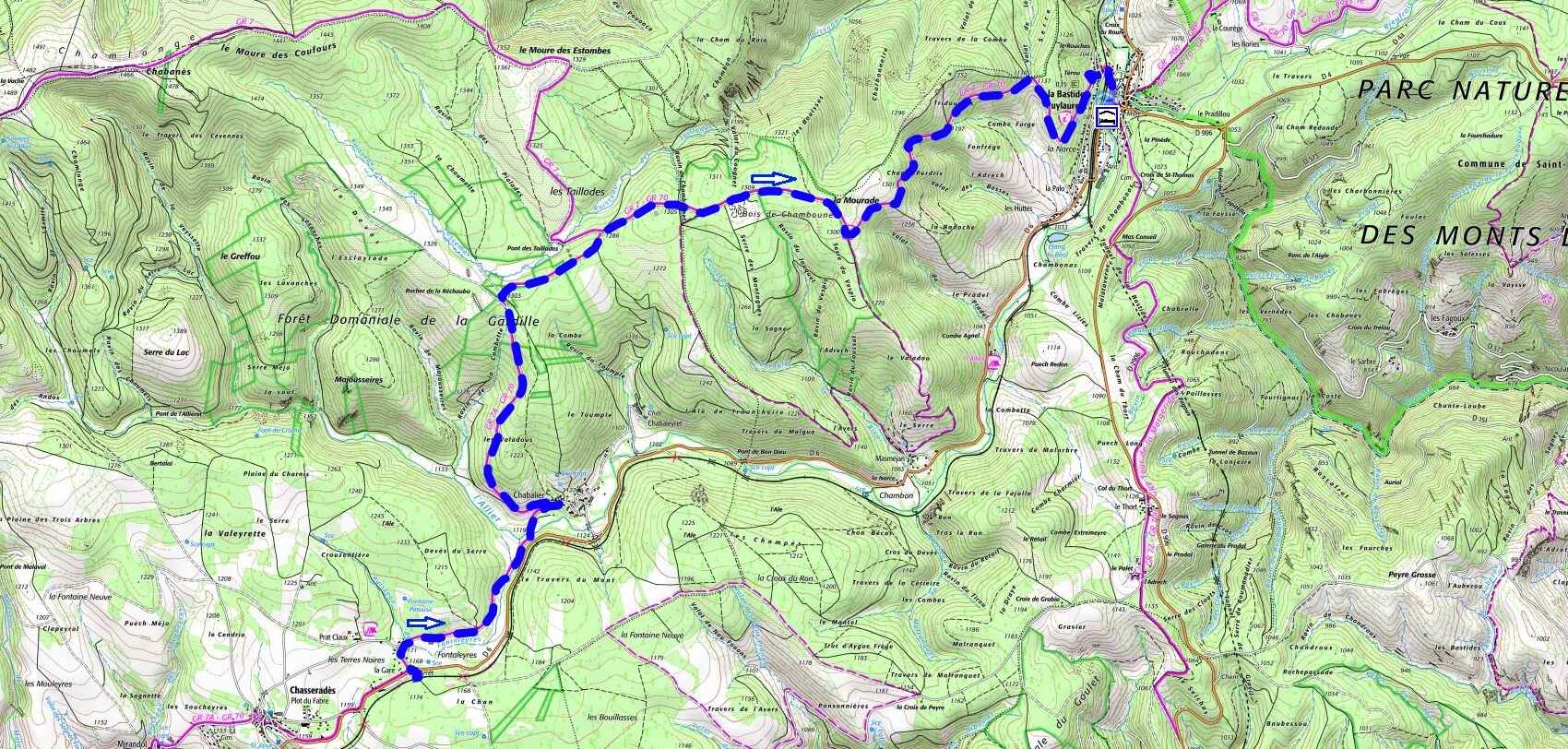11 km hike in La Bastide-Puylaurent |
Take the train from La Bastide Saint Laurent les Bains station (SNCF schedule) to Chasserades. From there, return to La Bastide by following the GR®70, the path taken by the Scottish writer Robert Louis Stevenson in 1878. Pass through the small village of Chabalier, then climb up to Moure de la Gardille, where you can discover the Goulet mountain and Mont Lozere. On your left, you'll see the Rocher de la Rechaubo, followed by the Taillades bridge. Cross the ravine and the Chambounet woods, where the wind turbines are located, then descend into the Allier valley towards La Bastide, with spectacular views of the Ardeche mountains and the Notre Dame des Neiges abbey in the distance.

4km - 11km - 11,2km - 14km - 15,5km - 16,3km - 19km - 21,5km - 23,2km - 24km
Google Maps - Google Earth - GPX








Distance: 11 km, Maximum altitude: 1313 m, Minimum altitude: 1021 m, Total elevation gain: 202 m
IGN Maps: La Bastide-Puylaurent (2738E). Largentiere la Bastide-Puylaurent Vivarais Cevenol (2838OT).
Chasserades is first mentioned in a 12th century document. It was then an important commercial and religious center. In the 16th century, the village was affected by the Wars of Religion. The village was burned and pillaged by the Protestants. It was rebuilt during the 17th century. On September 27, 1878, Robert Louis Stevenson shared a room at the old inn located in the center of Chasserades. He met the people responsible for the surveys for the construction of the viaduct, but the line was not opened until 24 years later. This line is one of the most picturesque in France, serving places from which one can go in search of menhirs, dolmens, cup-shaped rocks, montjoies, ancestral paths used since Antiquity by crusaders, transhumants, muleteers... and hikers. The muleteers came up from the south with wine, olive oil and salt to exchange them for straw, fodder, cheese, salted meat, cereals and legumes such as lentils, wheat, rye, barley etc. "At the end of an hour, I saw the village, perched on a rock, above a bend of the Chassezac. I arrived at the bridge, and stopped to contemplate the landscape. The village was surrounded by mountains and forests. The houses were made of stone and wood. In the distance, I could see the snow-capped peaks of Mont Lozere. I crossed the bridge and headed towards the village. The inhabitants were curious to see this Scotsman accompanied by a donkey. They stopped me in the street to ask me questions. I felt like a celebrity. I found an inn and settled in. I asked the landlady if she knew of a place where I could leave Modestine. She told me that there was a meadow near the river. I gave her Modestine's lead, and I let her graze. I walked around the village. I saw the church, the town hall and the market square. I met locals who invited me to have a glass of wine. I spent a pleasant evening in Chasserades."
The Stevenson Trail, inspired by the journey of the Scottish author Robert Louis Stevenson, crosses the Cevennes from Puy-en-Velay to Saint-Jean-du-Gard. This trail, also known as the GR®70, is a mid-mountain hiking route (average altitude of 1000 m) that takes walkers through varied landscapes, from the volcanic plateaus of Velay, through Gevaudan, to the mountains of Mont Lozere and the valleys of the Cevennes, rich in biodiversity. The trail starts at Monastier-sur-Gazeille in Haute-Loire. In four stages, it leads to La Bastide-Puylaurent, via Langogne and Le Cheylard-l’evêque, then joins Lozere, following wooded and hilly paths. The route passes through emblematic sites such as Mont Lozere and Col de Finiels, offering wide panoramas of the Cevennes and the lower Languedoc. The diversity of landscapes and cultures is the charm of the GR®70, linking the Catholic lands of Haute-Loire and Lozere to the Protestant lands of Ardeche and Gard. Historic villages and inns mark Stevenson's passage, in particular the Cevennes, land of the Camisards and symbol of Protestant resistance, with its chestnut groves, remote valleys and numerous natural and cultural remains.
Robert Louis Stevenson, a renowned author known for Treasure Island and The Strange Case of Dr Jekyll and Mr Hyde, nourished a quest throughout his life combining literature and real life. He aspired to a life free from Victorian conventions, addressing in his essays themes such as morality, religion and human relationships. Faced with a hypocritical and restrictive society, he explores new values in opposition to his time, seeking to live without attachment or constraint. His work and his travels reveal this desire to escape the constraints of society to embrace a nomadic and adventurous existence. Stevenson valued the discovery of the world, raw experiences and meeting others, in contrast to the coldness of the British of the time. At the heart of his writings, he questions the dark aspects of the human soul, anticipating the concept of the unconscious. In his letters and writings, particularly from his exile in Samoa, he describes a lifestyle harmonized with nature, emphasizing his fight against the surrounding forest and his taste for manual work, in contrast to his literary aspirations. He expresses an ideal of happiness accessible through simple values: the pleasure of small things, indulgence towards oneself, and an openness to the world through travel, whether physical or literary. Stevenson thus embodies a figure of the writer-traveler and the inspired moralist, marked by a life of adventure, constant travel and a deep reflection on the art of living and feeling.
Former holiday hotel with a garden along the Allier, L'Etoile Guest House is located in La Bastide-Puylaurent between Lozere, Ardeche, and the Cevennes in the mountains of Southern France. At the crossroads of GR®7, GR®70 Stevenson Path, GR®72, GR®700 Regordane Way, GR®470 Allier River springs and gorges, GRP® Cevenol, Ardechoise Mountains, Margeride. Numerous loop trails for hiking and one-day biking excursions. Ideal for a relaxing and hiking getaway.
Copyright©etoile.fr